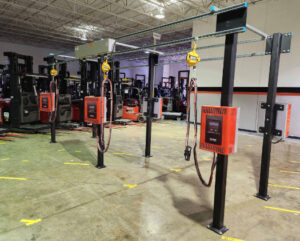In the realm of material transportation, efficiency, and reliability are paramount. With the advent of advanced technology, companies are constantly innovating to streamline operations while minimizing their environmental footprint.
One of the various technologies changing the material transportation industry is the innovation of Lithium Park and Charge Systems (LPCS). While important for powering electric vehicles (EVs), the impact they are making in the material handling industry is significant.
In this article, we dig into the fascinating world of Lithium Park and Charge Systems. We explore its components, infrastructure, functionalities, services MTC offers, and the impact LPCS brings to the battery handling industry.
The Rise of Lithium-ion Batteries
While they are common today, lithium-ion batteries have only been around for a little over 30 years. Sony commercialized the first lithium-ion battery and paved the way for a new era of energy storage. These batteries offer high energy density, longer life, and improved safety compared to traditional lead-acid batteries.
As the demand for clean energy continues to grow, the use of lithium-ion batteries probably will as well. So far, we have found that lithium-ion batteries aren’t ideal for every current battery room. However, we have seen an uptick in them in the battery-handling industry. And they are helping a worldwide issue, the desire of many, to reach more green industry goals.
Understanding Lithium Park and Charge Systems for Battery Handling Equipment
Lithium Parking refers to a comprehensive system that integrates lithium-ion battery charging infrastructure, management, and maintenance. It encompasses various components designed to optimize energy storage, distribution, and utilization. These components include charger columns, stands, and much more for battery charging stations.
For the layperson – it is like having a dedicated parking spot for your cell phone or EV to charge. Let’s explore some LPCS key elements for battery handling equipment:
Charger Stand Types
Different charger stand types cater to varying needs within the battery handling industry. Here are some of our more popular ones:
MTC CSHFM Series: This series is typically designed in a grid pattern. This pattern makes power distribution panels easier to integrate, reducing the utility work needed. CSHFM units provide quick access to energy replenishment for material handling equipment.

MTC CSHFMM Series: Versatile! Economical! Battery charging solutions that accommodate most high-frequency battery chargers on the market today. The series is universal and designed for fork truck fleets of all sizes. Strike a balance between efficiency and convenience with this series.
MTC CSHFMD Series: Universal crossmembers! Typically set up in a grid pattern similar to the CSHFM series, this model accommodates multiple opportunity chargers–making them a great choice for all types of warehouses with mixed fleets.
Power Distribution Panels
Power distribution panels serve as the nerve center of lithium park and charge systems. They manage the flow of energy from the grid to charging stations, ensuring efficient distribution and load balancing. They help eliminate the need to pull wire from the main electrical panel to each charger. These panels incorporate safety features and controls to optimize energy usage.
Charger Cable Retractors
Charger cable retractors enhance the user convenience and safety of LPCS. They automatically retract charging cables, preventing tripping hazards and reducing wear and tear. These retractors are essential for maintaining a safe battery room and clutter-free charging stations.
MTC Installation and Service
MTC’s installation and service play a critical role in the deployment of lithium park and charge systems. Our installation experts handle electrical connections, floor layout planning, and safety compliance. Their expertise ensures seamless integration of charging infrastructure into new or existing facilities.
Lithium Battery Management System
Lithium batteries typically incorporate all necessary electronics internally to track pertinent information on their own. So it is unnecessary for a battery management system. However, the MTC CCA Battery Management System is essential for effectively managing lead-acid battery rooms.
Remember, the lithium batteries don’t manage themselves, the forklift operator still needs to keep a close eye on them. To ensure your lithium batteries have a long life, we suggest you charge your battery when it reaches the 20-30% discharge zone. This will help ensure that our lithium park and charge solution operates efficiently for you.
The Future of Lithium Park and Charge Systems
As the adoption of lithium parking grows, challenges emerge. Effective recycling strategies are essential to manage spent batteries and recover valuable metals like cobalt and nickel. Developing sustainable practices minimizes environmental impact and supports circular economy principles. Hence the development of our line of products for park and charge material handling equipment!
Lithium Park and Charge Systems represent a paradigm shift in energy storage and distribution. From charger stand types to power distribution panels, these systems empower the transition toward cleaner, more efficient energy solutions. As technology evolves, MTC will continue to shape the future of material handling and transportation.
Stay tuned for updates on gomtc.com as we unveil our 3D rendering model of our Lithium Park and Charge Systems. Contact us to explore the limitless possibilities of LPCS in your facility!
